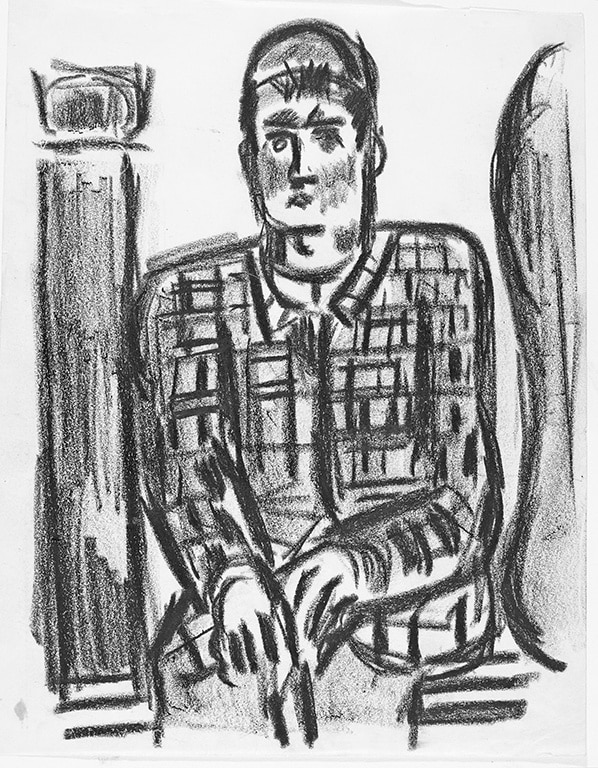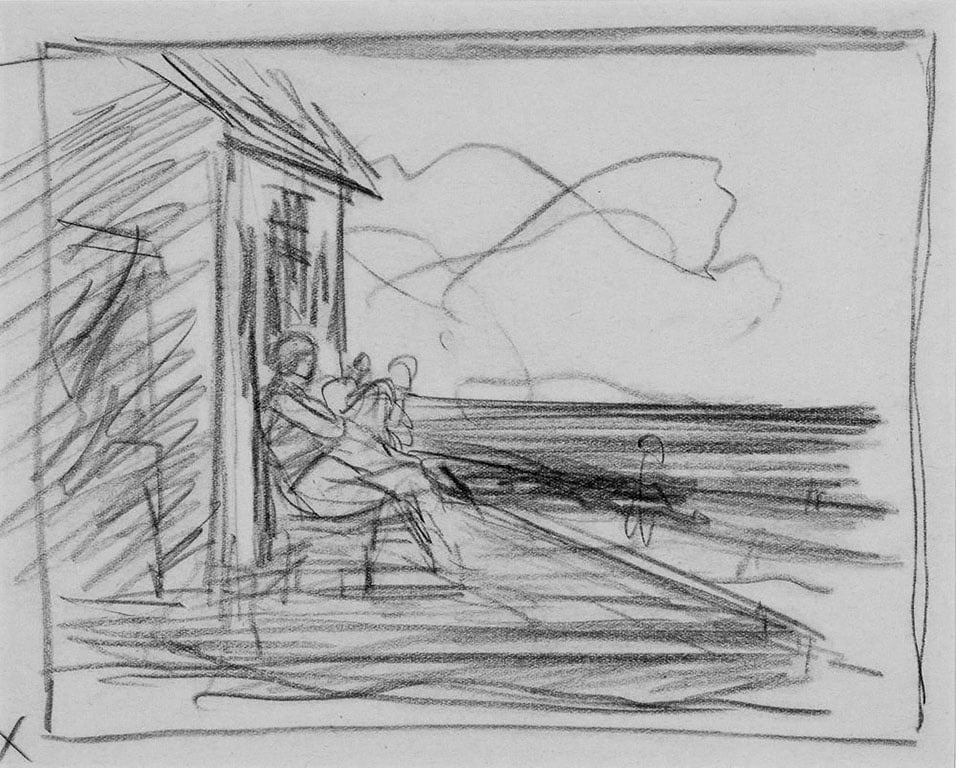Detail of Edward Hopper’s Study for Sea Watchers, (n.d., graphite on paper, PAAM Collection, Gift of Laurence C. and J. Anton Schiffenhaus in memory of Mary Schiffenhaus, and two anonymous donors)
PAAM Explores the Inner Minds of Marsden Hartley and Edward Hopper
by Steve Desroches
Artists Marsden Hartley and Edward Hopper were like two celestial bodies that occupied the same night sky and never collided, but at times did come into alignment. Born in Lewiston, Maine, Hartley became a significant figure in American modernism while Hopper, from Nyack, New York, became a master of American realism. Hartley lived life as a bohemian and was a closeted gay man, while Hopper could be reserved, a bit cold, and perhaps described as conservative with a small c. Hartley spent the summer of 1916 in Provincetown, giving it a superlative that stuck, “The Great Provincetown Summer,” while Hopper and his wife Josephine spent years in Truro, living a quiet life. In many ways they were total opposites, which is in part what drew Provincetown Art Association and Museum (PAAM)’s chief executive officer Christine McCarthy to put these two artists together in Hartley | Hopper: Drawings from Two New England Collections, a new exhibition now on display.
“I love the tension between art that might not go together,” says McCarthy. “Like the museum itself mixes two styles, I love what’s revealed when you put art and artists that seemingly have nothing in common together and what comes out of that.”
The exhibition is in partnership with the Bates College Museum of Art, located in Hartley’s home town and which, accordingly, has a large collection of his work. Hartley | Hopper: Drawings from Two New England Collections hung in the Maine museum last summer, with pieces of Hopper’s on loan from PAAM, as the Cape tip institution’s permanent collection boasts 600 items of Edward and Josephine Hopper’s work and papers. McCarthy worked with Dan Mills, the former director of the Bates Museum who has ties to Wellfleet, to co-curate this show, each picking 30 works as well as assembling artifacts to complement the exhibit. They spent years talking about this exhibit, which took almost a decade to get on the wall.

Hartley | Hopper: Drawings from Two New England Collections, focuses on the sketches and drawings of the two men who were best known as painters. In fact, many of the pieces on display are studies of works that followed, some considered to be masterworks. But while the two artists worked in vastly different styles, what the two have in common is revealed in these preliminary sketches. And while the two never met and there is no record of either commenting on each other’s work, their lives did follow similar trajectories. Both, of course, spent time in Provincetown, as well as in Gloucester, Massachusetts, and in Maine. Both studied under artist William Merritt Chase at the New York School of Art. And while the finished works of each was not often traditional, regional artistic subject matter, these sketches often featured drawings or even “doodles” of sailboats, fishing nets, lobster traps, and the like, giving evidence as to what each saw on a daily basis while working throughout maritime New England.
An interesting component of the exhibit, which also highlights the breadth of each museum’s collection, is the incorporation of personal papers and artifacts to breathe life into not just the work of the two men, who were both “big and hulking,” but as to their personalities and lives. The Bates Museum is home to a large amount of Hartley’s papers, while PAAM is the repository of many materials about the Hopper’s, including Josephine’s diaries, correspondence, photographs, and more. McCarthy describes Hartley as a bit of a vagabond, with few material possessions and always broke. He was the kind of friend that would take you up on an offer to visit for the weekend, but end up staying a month. But he was such a jovial kind of guy people enjoyed his company. When it comes to Hopper, the scenes of isolation in his work give insight into his personality. He rarely liked to socialize and the Hopper’s certainly never had house guests overnight, and if anyone did visit for a short time it was at the invitation of Josephine. Hartley, who died in 1943 at the age of 66, and Hopper, who passed at 84 in 1967, lived lives that produced work and created biographies that provide endless paths of exploration and where they might intersect in the ether and artistic zeitgeist.
“We didn’t say, ‘let’s do this to show where there are similarities or differences’,” says McCarthy. “But the more we got talking, you would see that the artists had much more in common despite how different they were. It’s got a lot of layers to it.”
Hartley | Hopper: Drawings from Two New England Collections, is at the Provincetown Art Association and Museum, 460 Commercial St., now through August 17. An opening reception will be held on Friday, July 18 starting at 6 p.m. For more information visit paam.org or call 508.487.1750.











